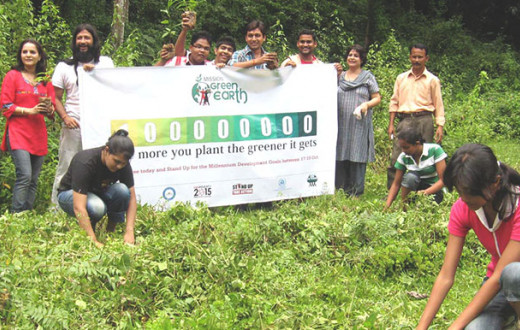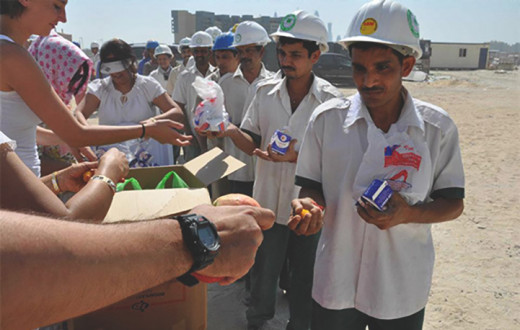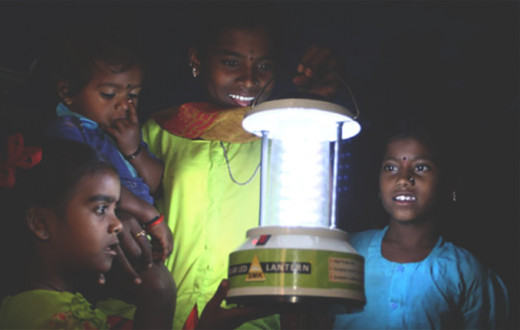Villagers in parts of the Indian state of Maharashtra, who have been under severe water crisis for years, heaved a sigh of relief at the sight of water in river basins. From struggling to find enough water for consumption and agriculture to seeing overflowing catchment areas, the villagers credit this turn of the situation to The Art of Living’s Jal Jagruti Abhiyan, a project launched to tackle Maharashtra’s recurring drought situation.
As a result of the project, the Tawarja river in Ausa Taluka and Gharni river in Shirur Anantapal, which were dried and dead, is now brimming with water, bringing cheers and benefits to the people of catchment villages.
The fruits of the labor under Jal Jagruti Abhiyan were seen during the monsoon of 2016 when rainwater was accumulated in the de-silted areas. In late February 2017, water was still present in the rivers and nullahs, reviving people’s hopes and restoring the ecological balance.
Within the short span of four years, the project has gained the trust of farmers and local communities who are eager to expand and build on the progress that has been made.
Currently, Jal Jagruti Abhiyan is working on de-silting and rejuvenation of 22 rivers and over a hundred canals across 15 districts and 49 villages in Maharashtra.
The water boom has led to the overall prosperity of the people around. Says a farmer, “The best indication of the same is the general trend reported by villagers that they don’t have to sell their land for their son’s education or daughter’s marriage.”
Jal Jagruti Abhiyan: The Beginnings
“We have always used the water from the holy rivers like Ganga and Yamuna to purify ourselves, but today we have reached a point where we have to purify this water. So, we are waging a war against pollution in our rivers. The government alone cannot do it. We will have to come together.”
~ Gurudev Sri Sri Ravi Shankar
Water scarcity has remained one of the most serious issues in Maharashtra, India.
While in 2009, Maharashtra registered below average rainfall, giving rise to a shortage of water, it was in 2012 when Maharashtra was confronted with an extremely severe water crisis. India’s second most populous state was now in the spotlight for being worst-hit by drought and a significant number of farmers committing suicides.
The Art of Living felt an urgent need to devise a long-term solution to tackle the state’s recurring water crisis. Inspired by Gurudev Sri Sri Ravi Shankar, The Art of Living launched the approach-based initiative Jal Jagruti Abhiyan or the Water Awareness Program in 2013.
Initially, the work under the project began on one nullah and a river, but over the years, the project has only gained more ground.
The most encouraging aspect of the project is the participation of people - leading to quicker implementation, higher cost saving, and a deeper community participation.
Impact of Jal Jagruti Abhiyan
Tawarja river now holds 230 crore liters of water along 13 kms of rejuvenation of total 25km.
Gharni river, which was once a nullah because of accumulated silt and growth of shrubs in the river basin, is cleaned and widened to hold 45 crore liters of water after the rainfall.
About 180 crore liters of water will now percolate in Gharni’s river basin.
It is estimated that the water supply will be enough to grow three yields per year for Maharashtra’s farmers.
During the clean-up, around 1,76,96,475 cubic meters of silt was removed from river basins and was spread in nearby fields to improve land fertility.
Groundwater table levels have increased considerably and water is available at a depth of 50 feet where de-silting work has been carried out.
Farmers have planted over two crops in their fields, in areas impacted by the river rejuvenation project.
District-wise listings of rivers
Name of district
| Name of river
|
Latur
| Gharni, Tavarja, Jana, Mudgul, Manjara, Rena
|
Jalgaon
| Waki
|
Osmanabad
| Terna, Rajegavi, Benitura, Bori
|
Jalna
| Narola, Kasura, Galhati
|
Nandurbar
| Gomai
|
Pune
| Shivganga
|
Nagpur
| Veena
|
Nasik
| Waghadi, Punzan, Kalki, Shivnadi
|
Satara
| Manganga
|
“Thousands of people like you, in the villages, talukas, and districts are fighting for water conservation on an extremely large scale. Youth, mothers, sisters, elderly people all are working for this cause. In Maharashtra, our Gurudev Sri Sri Ravi Shankar’s The Art of Living has done a wonderful job and others have also done this work together with the people.”
~ Devendra Fadnavis, Chief Minister, Maharashtra
Our approach
The success of Art of Living can be attributed to its three-fold approach:
Comprehensive: Provide local solutions in a scientific manner that mimic natural systems of restoring water.
Sustainable: Solve immediate needs of giving people access to safe water and also create systems that ensure reliable supplies in the future.
Community-driven: Empower local communities through capacity building frameworks.
Testimonials
"Due to the river rejuvenation project, financial upliftment has taken place. I am grateful towards Art of Living, Gurudev Sri Sri Ravishankar for the work.”
~ Ramesh Solankhe, a farmer
“Despite the water scarcity, I chose to farm as a profession. As the river rejuvenation work progressed, I am proud and grateful that I remained determined to go ahead with the farming profession. I have become financially independent as the water problem has been sorted. I am determined to take farming to next level and make it a natural farming model.”
~ Bhaskar Solankhe, a youth farmer
Story credit: The documentation team, Art of Living Bureau of Communication








